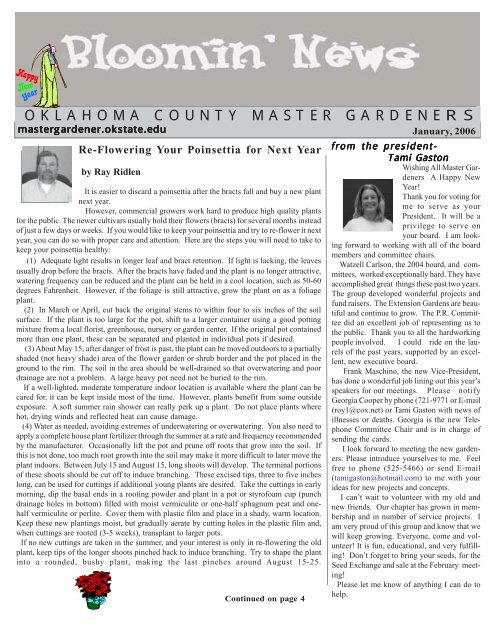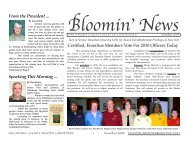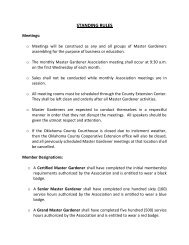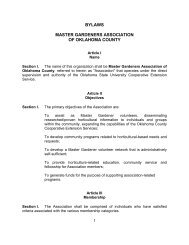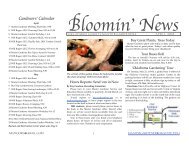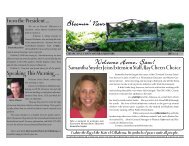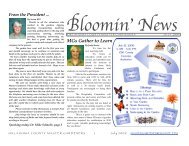O K L A H O M A C O U N T Y M A S T E R G A R D E N E R S
O K L A H O M A C O U N T Y M A S T E R G A R D E N E R S
O K L A H O M A C O U N T Y M A S T E R G A R D E N E R S
- No tags were found...
You also want an ePaper? Increase the reach of your titles
YUMPU automatically turns print PDFs into web optimized ePapers that Google loves.
O K L A H O M A C O U N T Y M A S T E R G A R D E N E R Smastergardener.okstate.eduRe-Flowering Your Poinsettia for Next Yearby Ray RidlenIt is easier to discard a poinsettia after the bracts fall and buy a new plantnext year.However, commercial growers work hard to produce high quality plantsfor the public. The newer cultivars usually hold their flowers (bracts) for several months insteadof just a few days or weeks. If you would like to keep your poinsettia and try to re-flower it nextyear, you can do so with proper care and attention. Here are the steps you will need to take tokeep your poinsettia healthy:(1) Adequate light results in longer leaf and bract retention. If light is lacking, the leavesusually drop before the bracts. After the bracts have faded and the plant is no longer attractive,watering frequency can be reduced and the plant can be held in a cool location, such as 50-60degrees Fahrenheit. However, if the foliage is still attractive, grow the plant on as a foliageplant.(2) In March or April, cut back the original stems to within four to six inches of the soilsurface. If the plant is too large for the pot, shift to a larger container using a good pottingmixture from a local florist, greenhouse, nursery or garden center. If the original pot containedmore than one plant, these can be separated and planted in individual pots if desired.(3) About May 15, after danger of frost is past, the plant can be moved outdoors to a partiallyshaded (not heavy shade) area of the flower garden or shrub border and the pot placed in theground to the rim. The soil in the area should be well-drained so that overwatering and poordrainage are not a problem. A large heavy pot need not be buried to the rim.If a well-lighted, moderate temperature indoor location is available where the plant can becared for, it can be kept inside most of the time. However, plants benefit from some outsideexposure. A soft summer rain shower can really perk up a plant. Do not place plants wherehot, drying winds and reflected heat can cause damage.(4) Water as needed, avoiding extremes of underwatering or overwatering. You also need toapply a complete house plant fertilizer through the summer at a rate and frequency recommendedby the manufacturer. Occasionally lift the pot and prune off roots that grow into the soil. Ifthis is not done, too much root growth into the soil may make it more difficult to later move theplant indoors. Between July 15 and August 15, long shoots will develop. The terminal portionsof these shoots should be cut off to induce branching. These excised tips, three to five incheslong, can be used for cuttings if additional young plants are desired. Take the cuttings in earlymorning, dip the basal ends in a rooting powder and plant in a pot or styrofoam cup (punchdrainage holes in bottom) filled with moist vermiculite or one-half sphagnum peat and onehalfvermiculite or perlite. Cover them with plastic film and place in a shady, warm location.Keep these new plantings moist, but gradually aerate by cutting holes in the plastic film and,when cuttings are rooted (3-5 weeks), transplant to larger pots.If no new cuttings are taken in the summer, and your interest is only in re-flowering the oldplant, keep tips of the longer shoots pinched back to induce branching. Try to shape the plantinto a rounded, bushy plant, making the last pinches around August 15-25.Continued on page 4January, 2006from the president-Tami GastonWishing All Master GardenersA Happy NewYear!Thank you for voting forme to serve as yourPresident. It will be aprivilege to serve onyour board. I am lookingforward to working with all of the boardmembers and committee chairs.Watzell Carlson, the 2004 board, and committees,worked exceptionally hard. They haveaccomplished great things these past two years.The group developed wonderful projects andfund raisers. The Extension Gardens are beautifuland continue to grow. The P.R. Committeedid an excellent job of representing us tothe public. Thank you to all the hardworkingpeople involved. I could ride on the laurelsof the past years, supported by an excellent,new executive board.Frank Maschino, the new Vice-President,has done a wonderful job lining out this year’sspeakers for our meetings. Please notifyGeorgia Cooper by phone (721-9771 or E-mail(roy1@cox.net) or Tami Gaston with news ofillnesses or deaths. Georgia is the new TelephoneCommittee Chair and is in charge ofsending the cards.I look forward to meeting the new gardeners.Please introduce yourselves to me. Feelfree to phone (525-5466) or send E-mail(tamigaston@hotmail.com) to me with yourideas for new projects and concepts.I can’t wait to volunteer with my old andnew friends. Our chapter has grown in membershipand in number of service projects. Iam very proud of this group and know that wewill keep growing. Everyone, come and volunteer!It is fun, educational, and very fulfilling!Don’t forget to bring your seeds, for theSeed Exchange and sale at the February meeting!Please let me know of anything I can do tohelp.
2 Bloomin’ News November, 2005If I haven’t met you, I’d like to!By Jane HaysI retired from the FAA in 1998 and by2000, I was looking for some-thingmeaningful to do. On a trip to Will RogersGarden Center, I found an application forthe Master Gardener class. I decidedthat was exactly what I needed! Myparents had been gardeners, and I loveplants. I applied for the class and wasaccepted. My life has been better for it.Cleve Kinzy was my counselor and mentor. He’s a great person,and I missed him during classes this year. I’ve also been blessedwith help and friendship of Paula Leazure, Susan Hill, CarolineCottingham, Jackie Ballenger and numerous others. I’ve been acounselor for three years and truly enjoy it – the new studentsare always great! I enjoy the fellowship of the meetings (and thewonderful food), the great speakers, and the learning experience.I have been a member of the Public Relations, Telephone,Speakers and Gardening committees. I’ve just finished my firstyear as Secretary, and am looking forward to the coming year.Secretary is a neat job, and I like working with other officers andcommittee chairs.My main interest is shade gardening. I love hostas, columbinesand other shade plants. Gardening in my clay soil is quite achallenge and I admit that it gets the best of me sometimes, butI’m not a quitter.I love being a Master Gardener. The Association keeps growingand getting better. We’re getting smarter too – we have moneyin the bank!My thanks for allowing me to serve as Secretary for anotheryear. To each of you: If I haven’t met you, I’d like to!Flowers, Finance & Non-FelinesBy Kay CondrenI have had flower gardens all of my adult life,but have only been a Master Gardener since2000. In my previous life, I married mychildhood sweetheart (Bill) in 1957. I workedin various office jobs, until we adopted ourchildren in 1966 and 1969. I’ve worked as avolunteer in PTA, Boy Scouts, Camp Fire,and church.After our children got older, I went to work as Director of Finance andProperties for the Girl Scouts, from which I retired in 2000.I also took dog obedience training classes with my dogs, and taughtcanine obedience classes for several years.I had a friend, Mary Barringer, who was a Master Gardener. Maryinfluenced and encouraged my decision to apply for the program. Ifound out before the classes were over that there are lots of really greatpeople in Master Gardeners. The amount of knowledge that existswithin our group is amazing!I love to work on the telephones and also enjoy serving on a couple ofcommittees. My favorite Master Gardener project to date, has beenworking on the Education committee as a counselor. I served as EducationCoordinator this past year and I enjoyed it, but find that I would ratherbe a counselor.The benefits of membership in our organization for me are meetingnew people, making new friends, and learning something new everytime I answer phones or attend a meeting.A few of the Master Gardeners who have helped me as mentors or rolemodels are Cleve Kinzy, Tami Gaston, Opal Zschiesche, and MaryLaurent.Four Master Gardeners who I think deserve our thanks and recognitionare Gerald Luton, Paula Leazure, Kaylon Hand, and Schroeder Wilson.Thank you for electing me Treasurer for 2006!Congratulations Class of 2005Welcome to our Master Gardener Family!!Janet Sherry, Page Editor and Designer
3 Bloomin’ News November, 2005Creamy Chicken LasagnaBy Georgia CooperCan you ID It? ** See below for the answer!2 c. shredded mozzarella cheese,divided2 cans Campbell’s condensedCream of Mushroom Soup1½ cups milk1/8 tsp ground nutmeg1/8 tsp ground red pepper (cayenne)1 pkg (10oz) frozen chopped spinach,thawed and well drained1 egg1 container (15 oz) ricotta cheese9 lasagna noodles, cooked and drained2 cups diced cooked chicken½ cup grated parmesan cheeseReserve 2/3 cup of mozzarella cheese for top layer.In medium bowl, combine soup, milk, nutmeg and red pepper;set aside.In another medium bowl, combine spinach, egg and ricotta; mixwell.In bottom of 13- by 9-inch baking dish, spread ½ cup of soupmixture. Arrange 4 lasagna noodles on mixture. Top with 1/3 ofremaining soup mixture, ½ of spinach mixture, ½ of remainingmozzarella and ½ of the chicken.Repeat layers ending with remaining noodles, soup mixture,reserved 2/3 c. mozzarella cheese and Parmesan cheese.Bake at 350 for 40 minutes or until hot and bubbling. Let stand15 minutes before serving. Makes 8 servings.————————A Garden ChecklistFor January 2006Southern Living Magazine“Garden Planning – Now is the time to stay near the fireplaceand plan the landscape of your dreams. Scan catalogs andmagazines for inspiration, or order flower seeds for a cutting bed.You can also start a garden journal by writing down importantdates throughout the year including bloom times, rainfall, etc.Make an effort to do something different this year in your yardsuch as growing a container full of vegetables, trying a new plant[see Margaret Biggs article on page 5], or simply rooting a coleus.The best way to learn is from experience, so get out in the garden,and grow a little.”Photo by Janet Sherry © 2005————————So Much More than aStaff Secretary …Janet BirchallShe grew up in El Renowith seven brothers and sisters.After attending Oklahoma StateUniversity for two years, she received her Associate’s Degree,married and had three lovely daughters.When she isn’t helping out Master Gardeners and all the othervolunteer service groups affiliated with OSU, and helping thestaff and the public, she finds time for just a few hobbies! Janetenjoys sewing (she’s learning to quilt), reading, cooking, andeasy gardening.We thank Janet Birchall for nine years of service with the OSUExtension Center and Oklahoma County Master Gardeners!————————** Scarlet hibiscus (aka Texas Star Hibiscus and on occasion,aka Swamp hibiscus) is a shrub like herbaceous perennial thatdies back in winter, and re-sprouts in spring. Established plantscan have one to several stems up to 7' tall. The five petaledflowers are brilliant crimson red and 6-8' across. Each lasts only aday, but new ones continue to open all summer and fall. I growmine in submerged pots in my backyard pond, with just the top ofthe pot at the surface level. One of my plants has over winteredthe past 5 years! Janet SherryJanet Sherry, Page Editor and Designer
page 4Bloomin’ News October, 2005Re-Flowering Your Poinsettia for Next Year page 1 How to Prune• Never remove more than 1/3 of tree branches or 2/3 of shrub branches• Remove dead and diseased limbs• Don’t dehorn or top trees (the way utility company does)• Large limbs with collars should be removed flush with the collar(leave the collar.) Make several cuts and under cuts to prevent splitsand rips in the bark.• Smaller limbs without collars should be removed flush with the trunk.If too many shoots result, carefully prune off a few excess branches.Plants can be transplanted to a size larger container if they appear tobe outgrowing the pot. If the plants appear to be in proportion to thepot, simply leave the plants in the old pot.(5) Lift the pots from the flower garden or shrub border in lateSeptember. Bring the plants inside and place them in a sunny window.Avoid “burning’ light, but don’t give too much shade or leaf drop,spindly growth and sparse blooming may result. Follow previouslymentioned watering practices.Use a house plant fertilizer during this indoor forcing period,following the manufacturer’s recommendations relative to rate andfrequency. Do not apply more fertilizer than recommended.Poinsettias must have long, uninterrupted nights to bloom and inorder for the plants to flower for Christmas, they should be kept incomplete darkness from 6 p.m. to 8 a.m. each night, beginning in lateSeptember. Just be sure to place them back in the sunny window eachday. This can be as simple as placing the plant every evening in alight-proof box or in a closet. Follow this procedure until good bractcolor is showing. If possible, the temperature should remain between60 to 70 degrees.Whether you prefer trying to re-flower your poinsettia or purchaseanother the following Christmas, enjoy the poinsettia’s flaming beautyeach year. This living symbol of a joyous season is a colorful part ofthe American Christmas tradition .Pruningby Bill EdwardsPruning trees and shrubs can be done well, butthe methods and timing for pruning are controversial.Here are some guidelines to consider.When to Prune?Deciduous trees can be pruned generally in anyseason, however, the best time to prune is duringwinter dormancy, December through February,when their sap flow slows. There will beless stress and no active borers during this time.Bleeders, such as Birch, Elm, Maple, and Willow, should only bepruned November 15 through January. If pruning is really needed,you can lightly prune in July.Spring flowering trees and shrubs, such as Dogwood, Redbud,Crabapple, Lilac, Azalea, and Forsythia, should be pruned after flowersfade in early spring.Summer flowering shrubs, such as Rose of Sharon, Crape myrtle andButterfly bush, should be pruned in early spring, March.Fruit trees can be pruned January through early March.Evergreens pose special problems. Broad Leaf varieties, such asAbelia, Boxwood, Holly, Nandina and Photinia are pruned just beforenew growth in spring.Narrow Leaf types, such as Fir, Pines and Spruce, should have theirlimbs pruned in January. If a formal shape is desired, candles may bepruned when they are tan colored, and before needles reach full length.Always leave one half of the candle, and never prune the top leader.Arborvitae, Cedars, Cypress and Yews should be pruned in springbefore new growth begins. Pruning may be done again in May throughJuly to control growth.Sheer Madness ( Pruning 101)by Dalia WoodliffLate summer, I was guilty of sheer madnessagainst Mocky, my once gorgeous Mock Orange.Mocky was a glory of orange, fragrantblossoms until my deadly-uneducated loppersmutilated it and turned it into Bonsai Mocky.So, guess who is now doomed to a refresher class on Pruning for Shrubs,Vines and Small Ornamental Trees?And who will be my captive audience?Rule 1: Prune most trees and shrubs during winter or early spring,December 21 through March 21, before buds form, preferably duringdormancy. The least desirable time for pruning most plants is afternew growth begins when the carbohydrates stored in roots and stemsare being used in development. This food in the stems and branchesshould be used to grow new foliage before removal or setback willoccur…in the form of dwarfism or starvation. Guilty as charged forputting many of my plants on a Low Carb Diet!Plants to prune during dormancy include: Barberry, Blackberries, Blueberries,Cottoneaster, Daphne, Gooseberries, Grapevines, Juniper,Pittosporum, Sumac and Winterberry. Fruit Trees, like Apple, Pear,Peach, Cherry, Plum, Apricot trees are pruned in March. BroadleafedEvergreen Shrubs should be pruned before growth starts in spring.Examples include Boxwoods, Camellia, Cherry Laurel, Eleagnus,Holly, Mahonia, Nandina and Photinia.Rule 2: Summer Flowering shrubs bloom on limbs produced the sameseason, or new wood, and should be pruned in early spring, March 22-June 22, before growth begins. Examples include Abelia, Althea, BurningBush, Butterfly Bush, Beautyberry, Clematis, Crape Myrtle, HardyHibiscus, Indigo Bush, Oleander, Peonies, Peegee Hydrangea, Spirea-Summer-Blooming, Summersweet and Vitex.You may prune these guys lightly in May for shaping: Arborvitae,Cedar, Cypress, Fir, Junipers, Spruce, and Yew.Rule 3: Spring flowering shrubs bloom on old wood, last year’s growth,and should be pruned as soon as the flowers fade. Since flowers areformed during the summer months, pruning in the summer, fall orwinter pruning will destroy the next year’s flower buds. I wish I hadpaid attention to this rule when I butchered my Mocky and my Lilac.Spring flowering shrubs include: Flowering Almonds, Crab andQuinces, Azaleas, Bridal Wreath, Chokeberry, Currents, Deutzia, Dogwood,Figs, Forsythia, Fringe Trees, Gardenia, Indian Hawthorn, Kerria,Lilacs, Magnolias, Mockorange, Mountain Laurel, Pyracantha,Rhododendron, Serviceberry, Smoketree, Tamarix, Viburnum, Vines(Jasmine-Trumpet-Honeysuckle and Wisteria), Weigelas, Willow andWitch Hazel.Rule 4: Roses like Hybrid Teas, Floribundas, Grandifloras, HybridPerpetuals and Polyanthas should be pruned in early spring, as budsare swelling, but before growth starts. Shrub Roses should be prunedafter flowering.Con’t on next page
5 Bloomin’ News November, 2005Sheer Madness ContinuedClimbing roses derived from Teas (peace or Glory) should be pruned heavily twice per year. Ramblers that flower in spring only should bepruned after flowering. Bush Roses should also be pruned in the spring, as they often start at a fast pace before it is a good time to prune.Rule 5: Use the proper tools - no chainsaws, please! Use hand shears for small plants, loppers for branches and a good pruning saw for thebigger branches. Remember these tools should be sharp and clean. Disinfect tools with ethyl alcohol after each use.Rule 6: Restrain yourself when it comes to tidying up the garden after pruning. Leaving a thin layer of leaves on the ground adds organicmatter to the soil, providing food for beneficial soil-dwellers like Willie the Worm as well as homes for the Wabbit family. Leaving berries onyour Hollies will feed hungry birds. Use your compost bin, chipper and shredder to make mulch to shelter beneficial insects important to plantpollination and (gasp-gasp) also a food source for birds and animals. A clean, scraped yard may result in tree, shrub and plant loss so restrainyour tidy urges and enjoy a healthier garden!I close with my stalwart oath on the head of my Mocky: I will not touch my loppers without checking these rules along with the fine chartproduced by Greg Cary and found on these pages in the past.If sheering madness overcomes me, I will take my Paxyl and will only remove 1) dead , injured or diseased branches 2) rubbing branches 3)inward growing branches. For overgrown shrubs, I promise to chop only 1/3 of the oldest stems to the ground. Further, I will avoid majorpruning in late summer and early fall (August-September), as this may cause winter kill.Confused Yet? I have seen many pruning philosophies on the internet, but the very best is still found at our OSU Extension HorticultureWebsite. An easy rule to remember: For a flowering shrub, consider when it flowers and whether on old wood or new. And good luck.Seed Exchange in Februaryby Debi WheelerBring your seeds, packaged and labeled to theFebruary meeting and we will exchange seeds.You can bring as many packages as you wantto contribute to the exchange and you will beable to take that many packages home! Seedscan be those you collected or seeds that you have bought and got morethan you need. Seed packages remaining after the exchange will befor sale, so please package some extra seeds so you can donate seedpackages to the sale.How Many Seeds to a PackageLarge sized seeds - 5-10 per packageMedium sized seeds - 10-15 per packageSmall sized seeds - 20+ per packageHow to Package:Please put in envelopes. Use letter size, coin envelopes, recycle old envelopes or cutpaper and make your own!Label, Label, Label:Botanical name, common namePerennial, biennial, annualDescription, Sun/shadeBloom time. Days to HarvestHeight and spacingMoisture loving/drought tolerantSowing Directions-When to sow inside before last frostDepth to cover seeds/surface sowDays to GerminationOptional:Your name and telephone number so people can call if they have any questions about theparticular plant they will be growing.Questions, ideas or want to volunteer to help call Debi Wheeler or Schroeder WilsonRemember to check the calendar on ourwebsite for phone duty openings,and call Janet at 713-1125.Something New Under the Sunby Margaret BiggsEvery year I try some new plants in mygarden. I found two this year that really impressedme. Both were drought and heat tolerantand did very well. I picked up talinumpaniculatum ‘Jewels of Opar’ at the Hort Students’spring plant sale. I had seen it offered in various plant catalogues,but this was the firsttime I had seen it offered asa plant. I put my two plantsin a dry, shady area. If theyperformed well there, Iwould be impressed and impressedI was. In no timethey had grown and soonhad a beautiful lime greenfoliage followed by smallpink flowers and finallysmall capsule-like seeds inshades from red to burgundy,which are of course the “jewels.” They bloomed continuouslyfrom mid-June until frost. The seed spikes were beautiful and longlasting in flower arrangements in addition to being lovely to look atin the garden especially when the wind caught them.Talinum paniculatum is an annual in Oklahoma, but it is supposedto reseed freely. I did research to write this and have discovered thatit should be planted in full sun. I’m keeping it in dry shade because Ihave not found many plants that perform in that situation. It can beinvasive. It is heat and drought tolerant according to my sourcesmaking it excellent for xeriscaping. The plant reaches a height of 18-24 inches. The flower spikes are delicate and elegant and it has noinsect problems.Read the February issue of Bloomin’ News to find out about my otherfind.
Page 6Go...Go...Go...Go...Go...Go...Go...Go...Bloomin’ News January, 2006As we begin 2006,January 4: Brian Pirtle , our host at the wonderful Juniper Hillresolve to bring a fresh and positive attitude.Nursery tour last spring will speak today. Brian is a popular, featuredspeaker, and we would have heard him last January, but icyLet’s work hard and enjoy each other as we learnroads cancelled our meeting. Brian is passionate about new plant and grow, showing visitors and each othervarieties and better ways to use them. We welcome him, thank him appreciation and respect.for coming today and hope that he will stay for lunch and visiting.Please make him welcome!Very Important: The new 2006 Master Gardener DirectoryFebruary 1: World famous tree specialist Steve Bieberich, of SunshineNursery, will share news of his world-famous tree varieties,is in the making, and we need your help. Please check yourlisting in the current directory and note any changes or updatesyou wish to have made in the 2006 directory. Callreminding us that no tree will do well where it doesn’t belong. It’sanother opportunity to hear an acknowledged expert speak. Please Caroline Cottingham, 340-9088 with your changes beforewelcome Steve Bieberich and thank him for coming on February January 1. 10. With your help we can keep your informationMarch 1: As new horticulturist for the Oklahoma County ExtensionOffice, Amy Brothers is our own. Just before spring, she will Gardeners.current and our directory a valuable resource for Masterpresent this, her first program for us. May we make her welcomeand hope for many more presentations in the future. Thank you, Please, report service hours monthly using one of these threeAmy, for volunteering your time and expertise.ways:March 11: Presented by Oklahoma County Master Gardeners:From the Ground Up, A Garden Workshop for the public, 8: 30 AM1. Drop report in Service Box at meetings.-1:30 PM . Registration is $15, or $20 after February 25. Fees and 2. Online link: mastergardener.okstate.edusoil samples are due to the Extension Office by February 28 be-3. Email: mghours@hotmail.comtween the hours of 8 AM and 4 PM, Monday through Friday. Call713-1125 to register.April 5: From our class of 2004, Oklahoma County Master GardenerJamesAshmore will discuss roses in the landscape. Some ofReport 20 Education hours when complete or by Dec. 31.Service hours alsoare due by or before Dec. 31us know James from his work at Under the Sun in Edmond andBloomin’ News is a publication of thehave already benefitted from his extensive knowledge about roses Oklahoma County Master Gardeners, produced in cooperationas well as other ornamental plants. Please thank James for his with pre-thsentation in April. It’s nice to hear chapter members who have spe-at meetings, the newsletter aims to inform, educate and entertain.Oklahoma County Extension Center. Distributed monthlycialized knowledge share it with the group.Material published here is believedto be horticulturally and factually correct.April: Another Roadtrip:Master Gardener will again travel JuniperHill Nurseryto visit with Brian Pirtle , then on to LavendertoCorrections, additions and comments may be sent toOklahoma County Master Gardeners NewsletterHill , etc. Thank Travel Chair Carolyn Hunter for planning such aC/O Ray Ridlen,timely, and educational trip to jumpstart spring.Oklahoma County Extension CenterMay 19: Pittsburg County Master Gardeners host Master the GardenerState Conference in McAlester. Each Oklahoma Master Gar-Oklahoma City, Oklahoma 73107,930 North Portland,dener will be mailed a pamphlet which to be used for registration. or by phone: 405-713-1125 or FAX: 405-947-1199.Members will choose from a variety of classes in the same timeslots, so enroll early to get your choices. Travel Chair Carolyn HunterBloomin’will reserve a bus for travel to the conference, and she will havemore details for us later. Thank Carolyn for a super job. Contact atthe MG office: Stephanie Larimer: 405-744-5404June 8-12: Southern Region Master Gardener Conference ,Chattanooga, TN. For information, visit http://srmgc.tennessee.eduMay 2-5, 2007: International Master Gardener Conference, May2-5, 2007, Little Rock, AR.NewsStaffPhyllis Church,EditorJanet SherryPage Editormastergardener.okstate.eduJackie PoguePage EditorSandi Price, CreatorWebMaster


